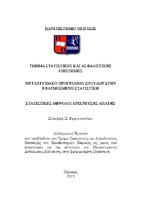Στατιστικές μέθοδοι ανίχνευσης απάτης
Statistical fraud detection

View/
Subject
Απάτη ; Λογιστική ; Στατιστική ; Ανάλυση παλινδρόμησης ; Neural networks (Computer science)Abstract
Nowadays the technological progress and the evolution of global communication contributed to the increase in fraud, resulting in the loss of billions of dollars worldwide each year. Although prevention by the aid of technology is the best way to reduce fraud, fraudsters will continue to invent ways allowing circumvention of such measures. Science will always move on developing mechanisms that prevent or discover human activity aiming at manipulation or deceive. Methodologies for the detection of fraud are necessary if we are enabling to identify and convict fraudsters. Their activation starts once fraud prevention has failed. Fraud detection is a sector of science that has undertaken the responsibility of discovering fraud. The progress in computer science equipped the scientists with the opportunity to develop new techniques and methods, transforming thus the computationally intensive algorithms into feasible solutions. At the same time, the ease with which we can collect and store data in a digital way has created bulky and continuously growing data sets. Statistical methods for fraud detection have been successfully applied in various sectors of society which include large data sets, some of them are health, telecommunications, economy and technology. It is not surprising the interest of the scientific community in finding techniques and methods for extracting information from these diverse and huge data sets. In this Msc thesis, we shall present some of the statistical methods used to detect fraud in a variety of some areas, and is given some detailed examples in order to understand more the mechanism by which we are led to the discovery of fraud based on available statistical data.


